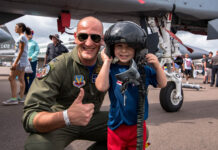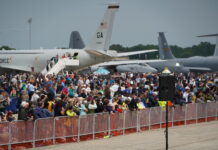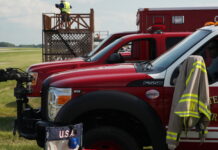Why You Should Conduct an Emergency Response Drill at Your 2017 Air Show
Two and a half years ago, ICAS member and air show performer, Eddie Andreini, was killed in a post-accident fire while performing at Travis Air Force Base in California. An NTSB investigation and video footage of the post-accident response both suggest that a faster reaction might have prevented his death. Andreini’s was the latest in a series of air show accidents involving slow emergency response dating back several decades.
Within a few days of the accident, the ICAS Safety Committee developed and circulated a detailed, step-by-step explanation of how to conduct a pre-show emergency response drill (see sidebar). ICAS recommended conducting this drill during the Friday rehearsal show to identify and correct any shortcomings in the written emergency response process. And since then, air shows all over the U.S. and Canada have been using these guidelines to plan and conduct their own drills. Anecdotal feedback from shows that have conducted these drills has reinforced the importance of the exercises and given us some preliminary ideas on how their use can be improved.
Generally, the different experiences with the drill fall into four different categories.
Some shows recognized the value of these drills, implemented them immediately, and found that their procedures worked well and allowed them to respond to a simulated accident within 60 seconds.
Other shows recognized the value of the drills, implemented them, found that the emergency response procedure was not executed properly or fast enough during the drill, and used that experience as an opportunity to correct problems prior to the Saturday and Sunday shows.
Either one of these outcomes is what we hoped for when we recommended the drills. But the other two categories of outcomes have also gotten our attention.
Some of our shows scheduled and conducted drills, found that there were shortcomings in the response, but then did nothing to address the deficiencies identified in the drill. That is, problems were identified, but not corrected.
And many events did not conduct the drills at all. Some opted not to conduct drills during the Friday rehearsal show to avoid sending the wrong message to the assembled media. In other cases, emergency response personnel indicated that their training and professionalism made the drills unnecessary. And some shows felt that a tabletop emergency response exercise made the Friday drill redundant.
As we move into the air show off-season, we’d like to encourage all ICAS members to consider (or reconsider) the value and importance of these drills.
Past experience – both good and bad – has demonstrated that an air show pilot’s chances of surviving an accident depend almost entirely on whether or not he receives help within 60 seconds of impact. And we also know from both actual emergencies and the growing number of simulated emergencies that, at most air show locations, a response time of 60 seconds is possible if the plan is strong, the first responders are prepared to respond quickly following an accident, and all possible complications are discussed and addressed prior to the emergency…actual or simulated.
In the 30+ months
since ICAS members began conducting these drills, we’ve also learned a few
other things:
- The drills are designed to help you identify deficiencies. But simply identifying them is not enough; it is critical that you also correct any problems that you discover.
- Communication is, by far, the most common and most significant complicating factor. Who authorizes the trucks to roll? What permission does a truck need to cross a taxiway or runway? Does the air boss talk to the fire chief, the tower or both? Are first responders cleared to roll as soon as an accident occurs or must they first be cleared by the fire chief? Often, these problems can’t be identified until they are uncovered in a simulated emergency, even when you think they are clearly explained in your written procedures.
- Because air shows are conducted in a non-standard environment, the emergency response often includes non-standard complications. There are fences, people, porta-potties and vehicles on a ramp that is normally empty. Lines of communication that are very clear on the other 362 days of the year are different and can cause disruptions or complications. The situation is different, sometimes very different, and that’s why a live drill is necessary.
- There is no substitute for these drills. Tabletop exercises are important and help to prepare an air show for a wide variety of emergencies. But, air shows should do BOTH a tabletop exercise AND an emergency response drill, not one or the other. When it comes to the specific challenge of responding quickly to a performer incident or accident, the drills prescribed by ICAS are a much better way to gauge preparedness and identify possible complications.
- There is no correlation between first responders’ confidence in their ability to respond within 60 seconds and their actual ability to respond within 60 seconds. No matter how sure they are that a drill is unnecessary, you should be just as insistent that it is.
- Often, when an air show descends on an airport for three or four days, firefighting professionals interpret requests for air show-specific drills as a challenge to their authority. Don’t let that happen. The non-standard nature of air shows and the once-a-year lay-out of the ramp during air show weekend mean that firefighters and other first responders are doing their normal business in an abnormal environment. We ask them to participate in a drill not because we doubt their competence, training or professionalism, but because we have put people and things on their airport that are not normally there during the rest of the year. Our drill is not a challenge; it’s an effort to double check and make sure that our air show isn’t complicating their response in ways that they might not have anticipated.
- Because Friday rehearsal shows are often media events, it is important to tell the media – before conducting a drill – what you are doing and why you are doing it. If you make it clear that this is a contingency exercise designed to prepare everybody involved with the show, should an emergency develop, then the drill becomes an opportunity to demonstrate your professionalism, preparedness and commitment to safety.
Beginning on January 1, 2017, the FAA will mandate pre-show emergency response drills of the kind recommended by ICAS. So, not only is it the right thing to do, it will soon be a requirement for conducting an air show in the United States. We urge you to embrace it as an opportunity to learn more about the effectiveness of your emergency response plan and the ability of your personnel to execute that plan quickly and effectively. That little bit of additional preparation may save a life.
Start Planning Now for the 2016 ICAS Convention
All of us here at ICAS headquarters are eager to see you at the upcoming ICAS Convention, December 5-8 at the Paris Las Vegas Hotel. Although we frequently engage in hyperbole to encourage your attendance at our big, annual industry get-together, this year’s convention is truly shaping up to be something very special.
Early attendance projections suggest that this might be the convention when we finally dig out from under the lingering effects of sequestration. Some ICAS members are still feeling the impact of 2013 and 2014, but the buzz and the numbers suggest that we may be turning a corner. All of our statistical indicators are pointing to a convention like those that we had in 2009, 2010 and 2011. Our education program is a full step and a half better than anything we’ve had in the last 20 years, with a larger number, wider variety and greater depth to the programming. And, my anecdotal conversations with members suggest that the air show community is genuinely excited about gathering together in Las Vegas early next month to renew old friendships, and continue the work of moving the industry forward.
You will find detailed information about the program and schedule elsewhere in this issue of Air Shows Magazine, so I won’t repeat details here, but – if you’re somebody who is on the fence about attending this year, or somebody who has always thought about, but never actually attended the ICAS Convention – I encourage you to have a look at the program we’ve developed and make plans to join us.
Thank You to Our 2016 ICAS Academy Hosts
This fall, for the first time since 2012, ICAS conducted its always popular ICAS Academy programs at the MCAS Miramar Air Show in San Diego in late September, and at the Bell Helicopter Fort Worth Alliance Air Show in mid-October. The financial challenges of sequestration caused us not to schedule either the ICAS Academy or the ICAS Air Boss Academy in 2013, 2014 or 2015. But, in response to popular demand, we re-introduced these programs to provide members with the unique air show learning environment that only our ICAS academies can provide.
In September, the air show team at MCAS Miramar welcomed our group of 12 ICAS Air Boss Academy participants with open arms. Under the tutelage of lead instructor Wayne Boggs, the group immersed itself in the intricacies and challenges of working as an air show air boss, using the MCAS Miramar Air Show as a readily-available example taking place in real-time as the course progressed.
In October, a group of 20 ICAS members gathered in Fort Worth for the ICAS Academy. During their very busiest time (Friday before the air show), subject matter experts from the Bell Helicopter Fort Worth Alliance Air Show gave mini-lectures on everything from marketing, sponsorship and hospitality to air operations, ramp lay-out and parking. On Saturday, the group roamed the ramp and shadowed air show staff to see what they do and how they do it to make Fort Worth one of the top air shows in the country.
Both programs were enormously successful, thanks in large part to the generosity of our hosts, particularly Ed Downum, recently retired air show director at MCAS Miramar, and Christina Carey, air show director for the Bell Helicopter Fort Worth Alliance Air Show.








